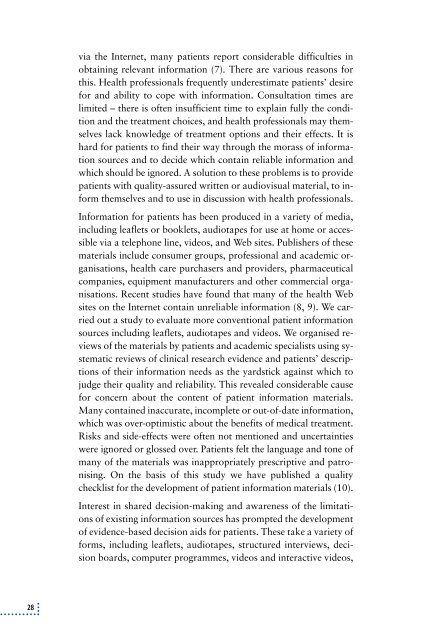MTV, sundhedstjenesteforskning og klinisk praksis
MTV, sundhedstjenesteforskning og klinisk praksis
MTV, sundhedstjenesteforskning og klinisk praksis
Create successful ePaper yourself
Turn your PDF publications into a flip-book with our unique Google optimized e-Paper software.
via the Internet, many patients report considerable difficulties in<br />
obtaining relevant information (7). There are various reasons for<br />
this. Health professionals frequently underestimate patients’ desire<br />
for and ability to cope with information. Consultation times are<br />
limited – there is often insufficient time to explain fully the condition<br />
and the treatment choices, and health professionals may themselves<br />
lack knowledge of treatment options and their effects. It is<br />
hard for patients to find their way through the morass of information<br />
sources and to decide which contain reliable information and<br />
which should be ignored. A solution to these problems is to provide<br />
patients with quality-assured written or audiovisual material, to inform<br />
themselves and to use in discussion with health professionals.<br />
Information for patients has been produced in a variety of media,<br />
including leaflets or booklets, audiotapes for use at home or accessible<br />
via a telephone line, videos, and Web sites. Publishers of these<br />
materials include consumer groups, professional and academic organisations,<br />
health care purchasers and providers, pharmaceutical<br />
companies, equipment manufacturers and other commercial organisations.<br />
Recent studies have found that many of the health Web<br />
sites on the Internet contain unreliable information (8, 9). We carried<br />
out a study to evaluate more conventional patient information<br />
sources including leaflets, audiotapes and videos. We organised reviews<br />
of the materials by patients and academic specialists using systematic<br />
reviews of clinical research evidence and patients’ descriptions<br />
of their information needs as the yardstick against which to<br />
judge their quality and reliability. This revealed considerable cause<br />
for concern about the content of patient information materials.<br />
Many contained inaccurate, incomplete or out-of-date information,<br />
which was over-optimistic about the benefits of medical treatment.<br />
Risks and side-effects were often not mentioned and uncertainties<br />
were ignored or glossed over. Patients felt the language and tone of<br />
many of the materials was inappropriately prescriptive and patronising.<br />
On the basis of this study we have published a quality<br />
checklist for the development of patient information materials (10).<br />
Interest in shared decision-making and awareness of the limitations<br />
of existing information sources has prompted the development<br />
of evidence-based decision aids for patients. These take a variety of<br />
forms, including leaflets, audiotapes, structured interviews, decision<br />
boards, computer pr<strong>og</strong>rammes, videos and interactive videos,<br />
28

















